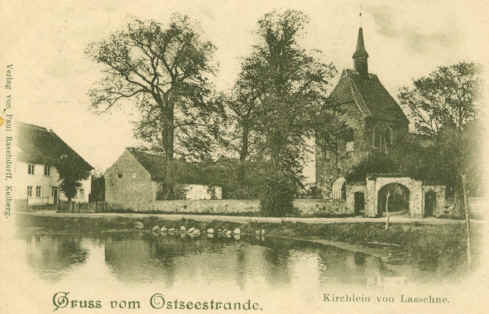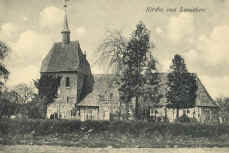Kr. Köslin, Pommern
(Lasin, Poland)

Prior to 1260, Lassehne was a Wendish village on the Wonnebach (red brook) near the Baltic coast just east of Kolberg. [from Map 9 on the Pommern.ws Weltseite website] In his book, "Pommersche Reminiszenzen", Horst Gädtke says that Germans, mostly from Lower Saxony and Westphalia, began migrating into this area in the second half of the 13th century and continued for about a 100 years. He states, "German nobles attained no fief possessions in the Kolberg region before 1260". As the German population gradually increased, the Wendish settlers moved eastward. By the middle of the 14th century, the total population had increased five-fold and the stream of German immigrants essentially stopped. From the 15th century on, the population of Pomerania increased almost exclusively by procreation.
During the 15th, 16th and 17th centuries, the landlords in this area had all descended from the noble Wendish family, von Kameke Cratzig. In 1678, von Kameke sold the Lassehne estate to Major General Bogislav of Schwerin who might have died soon after he acquired it. His brother Otto von Schwerin then inherited it. When Baron Otto von Schwerin died in 1679, the ownership of the Lassehne estate passed on to his son, Friedrich William von Schwerin. In 1722, Count Adrian Bernd von Borcke was enfeoffed with the Lassehne estate and in 1738 he obtained possession of Lassehne. Adrian Bernd Count von Borcke died on May 25,1741 and possession of the estate eventually passed to his son, the Major General Heinrich Adrian Count von Borcke in 1752 after a settlement was reached with his sisters. After he died, von Borcke's daughter, who married a von Arnim, inherited the estate. According to the Vasallen table of 1804, Lassehne, together with Henkenhagen, Lappenhagen, Wendhagen, Timmenhagen and Nitkenhagen were in the possession of Friedrich von Arnim of Heinrichsdorf in the Neumark at the beginning of the 19th century. On September 16, 1859, Bernhard Gabriel von Wedel married Elizabeth Eugenie Felicitas von Arnim, thereby gaining possession of Lassehne.
The manor house in Lassehne was probably built around 1740 by Count Adrian Bernd von
Borcke. Originally it was built as a manorial house with two transepts in the baroque style.
Around 1777 or 1778, a new manor house with a garden was built. The red-painted mansion, known as the “
rote Schloss”, served as a landmark for sailors on the Baltic Sea who used it for
orientation. The red Schloss was destroyed in 1945 when it was burned down by the Russians.

It is not known for certain when the Lassehne church was founded, but it is believed to have been in the second half of the 1200's or early 1300's. Achatius Kameke owned Lassehne during the Reformation and was one of the first in Eastern Pomerania who accepted Luther's teachings. Already in the year 1537, pastor Steffen Luchfeld was appointed as a Lutheran clergyman in Lassehne. The church and the lower part of the tower were originally constructed from field stone. The choir addition and the top of the tower were built almost entirely with bricks. The altar was constructed around 1600. Additions and renovations were made through the years; at times because of fire damage. The tower, which was 120 feet high in the early 1900's, was thought to be much higher at one time.
(click here for more photos of the church)
A picture of the interior of the church reveals a very interesting custom in churches along the Baltic coast. Although Lassehne was not a harbor village, sailors and fishermen from nearby Henkenhagen would bring model ships that they had carved and hang them from the ceiling as oblations or donations to the church. In former times there were as many as 12 to 15 model ships (called "Kirchenschiffe or Totenschiffe" i.e. church ships or dead ships) hanging from the ceiling. The church interior was also unique compared to other village churches I have seen in Naugard, Regenwalde and Saatzig counties. Considering the high roof, the nave had a relatively low ceiling supported by large beams and timbers. It is a shame that this beautiful church didn't survive the destruction of World War II. The damage was so extensive that the building was completely razed in 1951.
Lassehne, like most of Pomerania, was also devastated during the time of the 30-year war (1618-1648). In 1631, when the Imperial Army could no longer defend the villages, and had to retreat, they destroyed, plundered and finally burned them. However, the parsonage building in Lassehne, built for Pastor Bartholomäus Hiller a few years earlier, survived and was not set on fire. The parsonage remained in use until 1722 when it was replaced by a new building.
According to Carl Maass ( Deutsches Geschlechterbuch Band 134:381-382), the earliest documented origin of the Maass lineage was in Henkenhagen (now Ustronie Morskie), another small village about 2 miles west southwest of Lassehne. In 1573, Marten Maass (born ca. 1540) was a full farmer residing on a farm at Boltenhagen that he inherited from his father. In 1606, this farm, which was on the outskirts of Henkenhagen, was 40 ha. in size, or about 100 acres. [Note - Boltenhagen doesn't appear on any map of this area because the name was changed to Ulrichshof in the early 1600's. See map] As the Maass family tree expanded, descendants branched out; settling in Henkenhagen, Lassehne and other surrounding villages.1 However, the original Maass farmstead at Boltenhagen/Ulrichshof/Ziegenberg remained in possession of Maass descendants until 1945, when the entire German population was expelled from Hinter Pomerania. My 4th-great grandfather, Pagel Maass, who probably descends from Martin Maass, lived in Lassehne in 1781 when his son, Christian (my 3rd-great grandfather), was born. In 1802, Christian married Johanna Catarina Noerenberg who was born in 1779 in nearby Wendhagen (Wieniotowo).
L.W.Brueggemann [as cited by Horst Gädtke] gave this description of Lassehne in 1784, when Christian Maass would have been three years old [my thanks to Les Riggle for helping with the following translation]:
Lassehne is a knightly seat with a noble castle and garden, 2 meiles (about 10 miles) from Kolberg, in a level area, bounded on the northwest by the Baltic Sea and has 2 outlying farms named Rothenhof and Höfchen, 1 watermill, 1 windmill, 1 preacher, 1 sexton, 10 peasants, 2 pastor peasants, of which one has 2 Hufen2, the other has only 1 Hufe, 1 preacher's widow's house, 2 taverns, 1 blacksmith, 39 homesteads, a mother church belonging to the Köslin Synod, to which belong the villages of Henkenhagen, the outlying farm Ulrichshof, the sheepfold, the fishery station at the village of Henkenhagen, Wendhagen, Lappenhagen, which lies in the center of a forest and to Lassehne so-called knightly land with 5 Kossäten3 and a forest overseer; and in the years 1779 and 1780 the present owner of the Lassehne estate built a colony of 8 Büdnerfamilien4 , or small cottagers, in the same parish in the so-called long woods. The landed estate has black, loamy and fertile fields and good pastures; but, they, as well as the noble castle, are often flooded by the brook that flows through them to the Baltic Sea. The estate also has the rights to the stream and shore, the woods in the so-called Long Woods, and the wasteland.
Lassehne was always a small village and even in 1900, it only had 298 inhabitants. [W. Kornmesser-Lassehne, Die Kirche zu Lassehne, in: Illustrierter Kreiskalender für den Kreis Köslin, 1911 S.60 und 1912 S.13 cited by Horst Gädtke] A 1940 map of Lassehne shows the locations of the red Schloss, the church and cemetery, the school, and several other buildings and establishments.
Footnotes:
- Some Maass descendants even migrated back to the west. Around 1770, a Jacob Maass traveled to Hannover where he married and raised a family. Three of their sons moved further west in the1800's and became citizens of Aurich in East Frisia. Still later, around 1830, two grandsons migrated to Leeuwarden, Westfriesland (see Carl Maaß, 1963)
- Ahufe was the amount of land needed to sustain a large family. This may have been about 40 acres but the land area varied at different times in history and in different parts of the country depending upon soil conditions.
- Kossäten were ottagers who had less than a Hufe of land and would have to work for the estate part time.
- Families having a house and garden and small yard for chickens or a pig.
Sources:
Material for this brief history of Lassehne was taken from the following German publications:
- Gädtke, Horst 1997. Pommersche Reminiszenzen. Teil II - Pommersche Dorfgeschichte - Lassehne, Timmenhagen, Strippow-Herst.: Druckerei Heinen, 53902 Bad Münstereifel. ISBN 3-924383-07-3 - Brosch.. 218 Seiten.
- Maaß, Carl 1963. Deutsches Geschlechterbuch Band 134: 381-478. Fünfter Ostfriesenband Genealogisches Handbuch bürgerlicher Familien. Herausgeber: Regierungs-Vizepräsident a. D. Dr. jur. Edmund Sturtz. Verlag von C.A. Starke /Limburg an der Lahn.
- Vollack, Manfred 1999. Das Kolberger Land. Seine Städte und Dörfer. Ein pommersches Heimatbuch. p. 280-304. [The Kolberg LandBook].
Photos of the Lassehne church are reproduced here compliments of Dirk Petrat.
© - Gene Maas (2007 - 2010)
rev. 2 March 2010